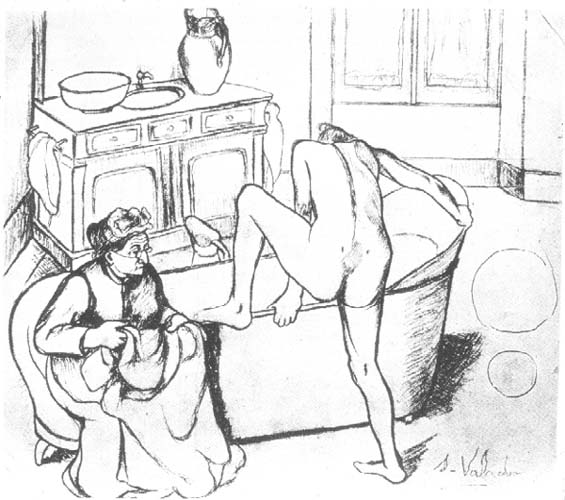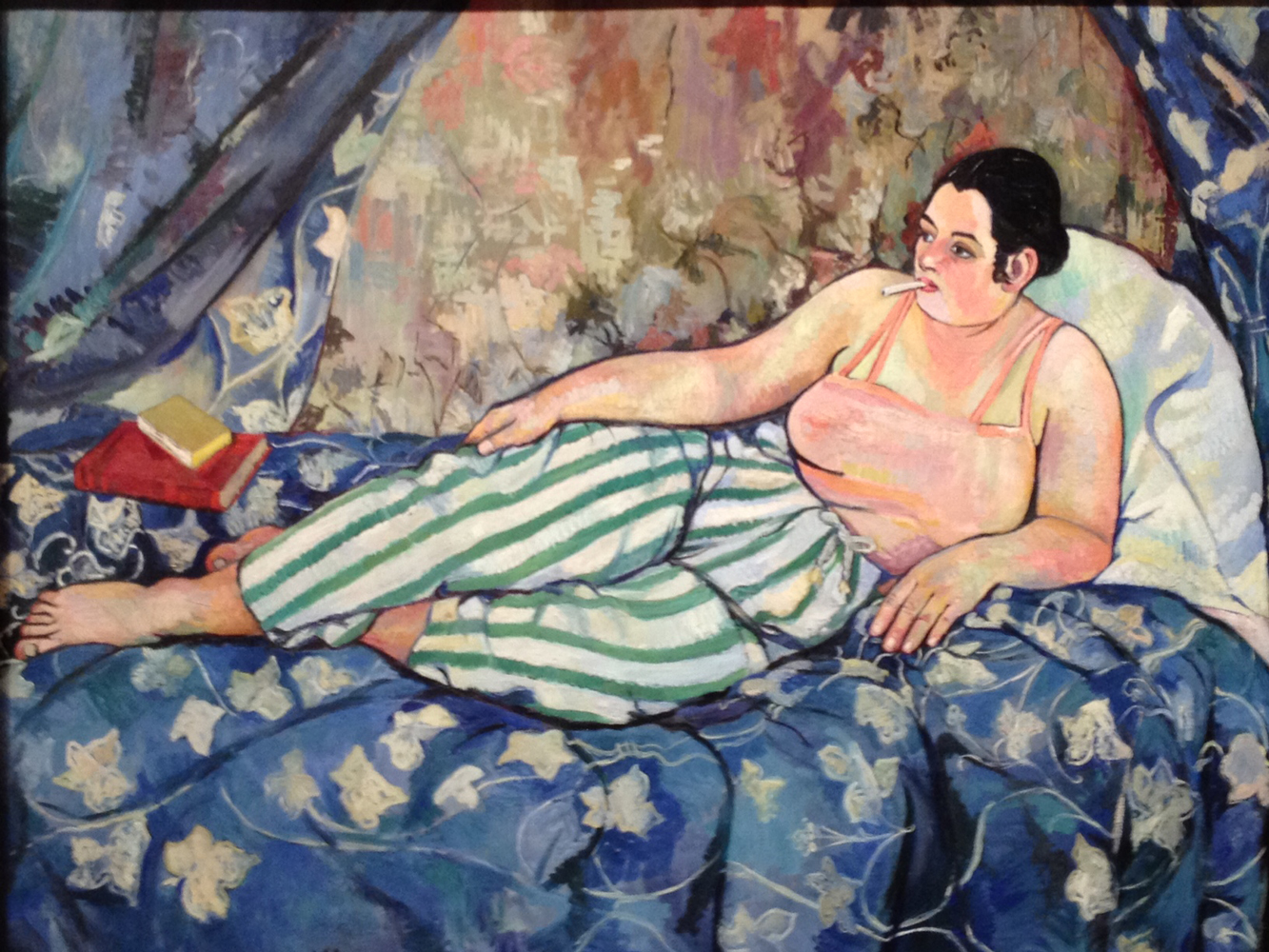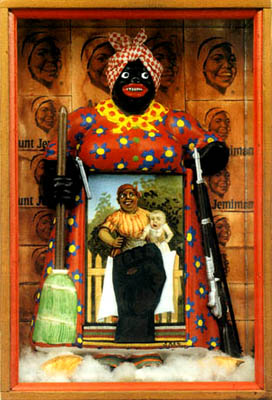 |
| Sonia Delaunay, Prismes Electriques, 1914 |
During
the first decade of the 20th century, after post-impressionism, and
Cubism, abstraction in painting and sculpture developed. This type of art did not represent an
accurate depiction of a visual reality but instead artist used shapes, colors,
forms and gestural marks to achieve its effect, and it can be also seen as an
art that represent the spiritual world or content. The Russian artist, Sonia
Delaunay, was very known during this period because of the way she used
geometric patterns and colors. In her work, she used to show and express the
modern period but not only working in painting but also in pieces such as
textile and embroidery; however, she decided to give up on her successful
career since her husband, as she said, become first when they married. The emergence of abstraction in fine art is seen as one of the
defining developments of Modernism, but modernism was more than that, it was
the innovation and
experimentation with form with a tendency to abstraction emphasizing techniques
and processes that gives the emerge of fashion when it was applied in clothing. Modernism search for a new form of expression, visual language, and it was
driven by various social and political issues. Chadwick states that, “modernity
is both linked to the desire for the new that fashion expresses so well, and
culturally tied to the development of a new visual language” (Chadwick,
253). In this time, Kandinsky was a male
artist that throughout his work inspired many other artists such as Weiss in
her participation of the Reform Dress Movement. This issue of reforming the
dress of women was very important, especially for feminists but it had a link
with socialism. Chadwick indicates this new healthy style as a shift from
earlier notions of clothing as indicating class and occupation to a more modern
preoccupation with clothing as a means of creativity identity” (Chadwick, 253).
The designs of Kandinsky placed a very important role in this issue since it
was him that experimented with fashion and help with this reform of freedom
from representation. Although Delaunay
was not publicly active, she continued to create and design within her home,
and around 1023 she obtained and showed the evolution in fashion, and designs
of textile. Many artists, including her, gave birth and support to this new
cause where women obtain a new identity, which generates changes considered
extreme at that time, but at the same time, it gives women the opportunity to
be independent and allows you to create the benefit of buying and consuming based
on their interests, and comfort of this new role.
 |
| Hannah Höch, DADA-Dance, 1919-21 |
During the time of the Dada
movement, elements such as art, music, poetry, theatre, dance and politics were
embraced. Chadwick states how Dada performances “helped break down earlier
notions about clothing as a cover for the body, replacing them with an image of
the body as a fluid screen, capable of reflecting back a present constantly
undergoing redefinition and transformation”(Chadwick,
274). Hannah Höch was also a
female active in the Dada movement. Her work promoted the idea of women working
creatively more generally in society. She
addressed in her pioneering artwork in the form of photomontage the issue of
gender and the figure of woman in modern society. Also her transformation of
the visual elements evidences an example of appropriation as artist technique.
In her work of DADA-Dance, Höch gives idea of challenging the view of the idealized female
body and indicates how women were become free. Dada became an international movement and
eventually formed the basis of surrealism in Paris after the war.
 |
| Suzanne Valadon, Grandmother and Young Girl Stepping into the Bath, 1908 |
 |
| Suzanne Valadon, The Blue Room, 1923 |
One of the female artists that worked in the nude female form and the real representation of it was Suzanne Valadon. This artist created powerful, unconventional, and sometimes controversial figure paintings, often of female nudes. Through her paintings and prints, Valadon transformed the type of the female nude by providing an insightful expression of women’s experiences by a woman's perspective. Her paintings such as The Blue Room or Grandmother and Young Girl Stepping into the Bath, demonstrates how she shifts from the idea of the woman being depicted as seductive and innocent and breaks the stereotypes showing the “natural womanhood”, the biology, and the real women that have power and must be seen equal to men. Surrealism brought new artist to embrace their conscious and unconscious feelings and express them in the artwork. Frida Kahlo is another female artist that can be an example of this movement, she explored the working of her mind, and she painted herself in many paintings depicting her own body in many states that she faced throughout her life.
 |
| Frida Kahlo, The Broken Column, 1944 |
 |
| Betye Saar, The Liberation of Aunt Jemima , 1972 |
Postmodernism was specifically a reaction
against modernism, which had dominated art theory and practice since the
beginning of the twentieth century. The term postmodernism is also widely used
to describe challenges and changes to established structures and belief systems
that took place in society and culture. This movement expresses symbolic
imagery, and also gives opportunity to express art through any form and it is
very important because other groups are considered equal and capable of doing
art, which before it was just selected for elite people. In
the Liberation of Aunt Jemima by Betye Saar, the artist breaks the idea of the
women of color as being submissive and creates a new empowered version of this
iconic figure. Aunt
Jemima was depicted with a broom in one hand and a pencil in the other with a
notepad on her stomach. Instead of the pencil, she placed a gun. In the spot
for the paper, she placed a postcard holding a biracial baby. The mammy’s skirt
is made up of a black fist. The book explains as “more of a
political movement that also involved identity because of the white culture's
stereotypical images of women of color and their roles” (Chadwick, 342).
In order to achieve her
goal, the artist used controversial and racist images to reclaim them and turn
them into positive symbols of empowerment. Even though Modernism and Postmodernism are two
of the movements, that display different characteristics, they both caused
drastic changes in society and the world. These movements, enhanced the worldview
by its new mode of interpretation, and these interpretations show both the
positive and negative conscious mind of the artist, and the society in general.
Works
Cited:
Chadwick,
Whitney. Women, Art, and Society. 4th ed. New York, N.Y.:
Thames and Hudson, .............1990. Print.
The
Guerrilla Girls' Bedside Companion to the History of Western Art.
New York: Penguin, .............1998.
No comments:
Post a Comment